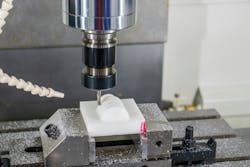CNC machining has advantages for plastic part production
By Peter Jacobs
Senior director of marketing, CNC Masters
Molded plastic products are used in everything from food packaging to farming tools to computers and sports gear. Additive manufacturing, injection molding and urethane casting are well-known methods of making solid plastic parts. But many plastics processors may be overlooking another process with unique advantages — CNC machining.
In many cases, CNC machining can be preferable due to its reliability, compatibility with a wide array of materials and ability to create parts with intricate geometries. This process makes it possible to obtain identical replicas of comparable quality for all reproductions of the same batch. They can be utilized for functional and aesthetic tests.
Top reasons to use CNC machining for plastic part production
Cost-effectiveness
Although machining plastics might get more costly than the injection molding process, it is generally economical to machine components instead of molding them. The initial expenditure on molds could be expensive for a single manufacturing unit to bear. While the molding process is less costly, you will still need to pay for the molds, so if you only need a few components or even a reasonably sized production run, CNC machined parts may be a more cost-effective route to go down.
Quick turnaround on prototypes
Plastic CNC prototypes are the finest option for anybody who requires a prototype to be ready rapidly. This is because creating a mold is not necessary. As a result, the procedure is reasonably quick, and the prototypes have a reduced cycle time.
Smoother finishes
Generally, the plastic parts you make must have a smooth surface finish to work effectively with the rest of the parts. Machined parts, as opposed to injection molded parts, can offer a smoother finish, resulting in no rough edges. If you already have a rough component from an injection mold, you can get it machined to eliminate the gates and level it out.
Maintain tighter tolerances
CNC plastic machining often achieves tighter tolerances than injection molding and other processes. Plastic CNC machining is an efficient manufacturing technique for products that require tight tolerance parameters. It is especially crucial for parts used in high-precision applications.
Top applications
Consumer products
CNC machined plastic components are extensively used in consumer products such as household items, appliances, sports equipment and toys. CNC machining can be used to produce objects such as casings, jigs, custom models and fittings in conjunction with prototype parts.
Electronics
CNC machined plastic components have nearly endless uses in the electrical and electronics industry as the sector comprises a broad range of products involving plastics. Brand owners require plastics in items such as electrical insulation materials, semiconductors, IoT equipment switches, mobile phones and other consumer electronic products. CNC machining can also be used for rapid prototyping of various electronic components.
Automotive
Parts for automobiles must be able to resist a variety of environmental conditions and stress-strain levels. The use of plastics in automobiles has grown dramatically. Machinists use several plastic materials for manufacturing automobile components spanning from the car’s bodywork to the chassis.
Plastic is also a suitable material for prototyping new automotive parts to be incorporated into vehicles. Because of the simplicity of machining, a faster cycle time is achievable, allowing companies to introduce innovations in the market more quickly. Plastic is used in automotive parts such as gauges, dials, AC vents, switches, etc.
Aerospace
There is hardly any room for manufacturing defects and errors in the aerospace sector because a slipup might generate drag in some aircraft sections or accelerate wear on some components. It is why prototypes are required in this sector most of the time.
CNC machined plastic prototypes are an effective tool to identify whether these parts are suitable for installation in the aircraft. Plastics are used in aircraft parts such as fuselages, ventilation ducts, rudders, etc., in addition to prototypes.
Defense
Plastic CNC machining offers a wide range of applications in the defense arena. It is a vital process in the military and defense industries, from its application in communication equipment to sections of transport systems.
Industry
Industrial CNC machining is commonly used for small and mid-high-strength components manufactured from engineering plastics, such as clamps, pulleys, valves and levers.
The process is particularly beneficial for specialized machinery parts when bulk manufacturing via injection molding would be economically unviable.
Medical
Medicine is constantly advancing, necessitating the procurement and development of equipment. Because of the unique properties of certain plastics, they are ideally qualified for medical applications where safety and sterilization are critical. In addition, the medical industry requires a high degree of precision and quality in its equipment.
It means that the equipment must be subjected to excessive sterilization levels regularly. Some CNC-machined plastic materials are ideal for this technique because they can endure autoclaving several times without deterioration. Other medical tools that use CNC-machined plastic include sterilization trays, imaging equipment, endoscopic probes and surgical equipment.
Food and beverage
Machinery components for the food and beverage industries must be durable enough to work all the time while being safe and delicate enough to interact with the foods people consume daily.
CNC machining assists engineers in striking this equilibrium. A popular material used in CNC machining, ultra-high-molecular-weight PE, complies with all regulatory standards. Anything from spray bars to production line equipment can be made using it.
How do you get a perfect finish on plastic parts?
If you already are utilizing CNC machining for plastic part production, are you getting the most out of your equipment? If not, here are some tips:
Avoid any cutting tool with complex geometries.
Don’t exceed the suggested feeding rate for the material you’re using.
Plastic materials that are to be machined must be kept firmly in position. Inappropriate clamping of materials causes instability, which leads to an uneven finish.
The cutting speed must also be within the ideal range, which varies depending on the plastic.
Are you still using the age-old mill for performing those milling operations? It’s time you move on to the new technology and have your own CNC vertical mill inside your workshop. These CNCs can increase production, improve quality and ensure consistency at a minimal price.
Conclusion
Plastics are used to make numerous industrial and consumer-grade products. Some components require a high degree of precision, reliability and tight tolerances. However, tooling costs can be high, increasing the price-per-part ratio. In contrast, CNC plastic machining can eradicate this expense, making the parts more inexpensive and allowing you to cut costs for customers. As a result, CNC plastic machining has become a popular option for manufacturers looking for durable and high-quality plastic polymers.

